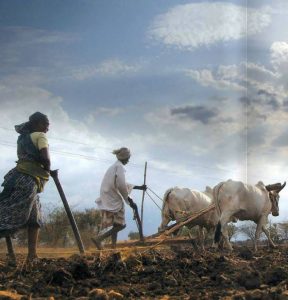 In two years of launch of the scheme, all the 18 companies put together made a profit of 15,795 crores. This seems to have defeated the very purpose of the scheme launched by the government to provide succor to farmers. The PMFBY says that its aim is to “To provide immediate relief to the insured farmers in case of mid-season adversaries causing expected yield to be less than 50 per cent of Threshold yield”. The scheme aims to provide for On-Account partial payment (up to 25 per cent of likely claims) without waiting for final yield data. The PMFBY is for compulsory coverage of all farmers.
In two years of launch of the scheme, all the 18 companies put together made a profit of 15,795 crores. This seems to have defeated the very purpose of the scheme launched by the government to provide succor to farmers. The PMFBY says that its aim is to “To provide immediate relief to the insured farmers in case of mid-season adversaries causing expected yield to be less than 50 per cent of Threshold yield”. The scheme aims to provide for On-Account partial payment (up to 25 per cent of likely claims) without waiting for final yield data. The PMFBY is for compulsory coverage of all farmers.
The Annual Report of Insurance Regulatory and Development Authority of India (IRDAI) for the year 2017-2018 sent by Dr.Subhash C.Khuntia, Chairman, IRDAI to the Secretary, Department of Financial Services, Ministry of Finance, Government of India confirms this fact. The report was sent to the Secretary vide letter No. 101/8/R&D/SD/AR-2077-18/01/Nov-18 dated November 28, 2018.
Enquires reveal that during 2016-17, the profit of 13 private companies was 3283 crores. In year 2017-18, it went up further and totaled 4863 crores. According to the annual report of the Insurance Regulatory and Development Authority of India (IRDAI), 11 private sector insurance companies collected 11,905.89 crores as premium. However, these insurance companies paid claims of only 8,831.78 crores to farmers thus making fast buck.
The IRDAI says that the Indian crop insurance market is dominated by government sponsored crop insurance schemes. Government Crop insurance program in India started with the introduction of Comprehensive Crop Insurance Scheme (CCIS) in 1985.
The CCIS was replaced by National Agricultural Insurance scheme (NAIS) in RABI 1999 which continued till 2015-16. Under both the schemes, NAIS and CCIS, administered premium rate was charged and claim liability beyond premium collected was shared by State and Central Governments.
 In the year 2016, the Pradhan Mantri Fasal Bima Yojana (PMFBY) was launched in the country. Hence from Kharif 2016, the PMFBY replaced the existing schemes. The Pradhan Mantri Fasal BIma Yojna is primarily an Area Yield Index based scheme, where losses (in reference to Pre-Notified Threshold Yield) for a notified area are determined based on requisite number of sample Crop Cutting Experiments (CCEs) under the General Crop Estimation Survey (GCES).
In the year 2016, the Pradhan Mantri Fasal Bima Yojana (PMFBY) was launched in the country. Hence from Kharif 2016, the PMFBY replaced the existing schemes. The Pradhan Mantri Fasal BIma Yojna is primarily an Area Yield Index based scheme, where losses (in reference to Pre-Notified Threshold Yield) for a notified area are determined based on requisite number of sample Crop Cutting Experiments (CCEs) under the General Crop Estimation Survey (GCES).
However, to reduce the basis risk under the PMFBY, localized losses (due to hailstorm, Landslide and inundation) and Post-Harvest losses (due to Cyclone/Cyclonic Rains &Unseasonal Rains) are assessed on Individual farm level survey basis. The PMFBY also protects farmers in the event of the ‘Insured area being prevented from sowing/ planting’ due to deficit rainfall or adverse seasonal conditions.
To provide immediate relief to the insured farmers in case of mid-season adversaries causing expected yield to be less than 50 per cent of Threshold yield., PMFBY provides for On-Account partial payment (up to 25 per cent of likely claims) without waiting for final yield data. The PMFBY mandates compulsory coverage for all loanee farmers and non-loanee farmers are also encouraged as well. The scheme is open to all food and oilseeds crops and annual commercial and horticultural crops. The unit of insurance is Village/Gram Panchayat for major crops; and for other crops the unit of size may be above this level.
While the Insurance companies charge the Actuarial Priced Premium Rate (APR), farmer has to pay a maximum 2 per cent for Kharif and 1.5 per cent for Rabi crops and 5 per cent for commercial/horticultural crops. The difference between actuarial premium rate and the rate of Insurance charges payable by farmers shall is treated as Rate of Normal Premium Subsidy, which shall be shared equally by the Centre and State Government. However, the governments are free to extend additional subsidy over and above the stipulated subsidy from its budget.
Ropar-based activist Dinesh Chadha, who procured the information under the RTI Act, says that “the Central government must make its position clear on the scheme”. Data reveals that 80 per cent of profit earned by private insurance companies went to companies like the HDFC that topped with 1,816 crores profit, followed by Reliance at 1,361 crores, Universal Sompo General Insurance Company 1,195 crore, ICICI 1,193 crore, Bajaj Allianz 815 crores, Bharti-AXA 302 crore, Cholamandalam MS 182 crores, Future General India Insurance Company 111 crore and Shriram General Insurance Company 107 crores.
Little doubt the Modi government’s ambitious crop insurance scheme has proved to be a jackpot for insurance companies than farmers. The Agriculture Ministry’s data also points to that when it says that 17 insurance companies-five public sector and 12 private empanelled under the PMFBY had registered a profit of 15,029 crores as they paid out claims of 2,767 crores against the premium of 17,796 crores. To add to it the PMFBY is exempted from Service Tax or GST.
 Subhash Sharma, an insurer with a public sector insurance company, told Tehelka that the private insurance companies may claim that profit was due to a good monsoon and resultant good production, but questioned why private operators were given more business as against public sector companies. Farm bodies counter claims to private insurers saying that there were drought like situations in some parts of Maharashtra and flood like situation in other parties, but still insurers made money. That calls for a re-think on the policy as PMFBY has mainly benefited insurers than farmers. Were farmers’ claims not settled?
Subhash Sharma, an insurer with a public sector insurance company, told Tehelka that the private insurance companies may claim that profit was due to a good monsoon and resultant good production, but questioned why private operators were given more business as against public sector companies. Farm bodies counter claims to private insurers saying that there were drought like situations in some parts of Maharashtra and flood like situation in other parties, but still insurers made money. That calls for a re-think on the policy as PMFBY has mainly benefited insurers than farmers. Were farmers’ claims not settled?
Information also reveals that the prime minister’s crop insurance scheme has also failed to enthuse farmers. About 2.90 lakh farmers exited the scheme in Madhya Pradesh, 31.25 lakh in Rajasthan, 19.47 lakh in Maharashtra and 14.69 lakh in Uttar Pradesh. In the year 2016-17, 5,72,17,159 farmers had joined the scheme but the very next year that is 2017-18 84.47 lakh farmers exited it. In fact in all about a whopping one crores farmers had exited the scheme after just a year. Was that the farmers fond that the scheme was meant to be a moneymaker for private insurance companies only?
The data also reveals that the number of farmers covered under the scheme had decreased, but the profit of the insurance companies increased.
For instance in Uttar Pradesh, the number of farmers insured in 2016-17 was 67.69 lakh but fell the next year to 53 lakh in 2017-18. However, the difference between premiums received and compensation paid instead of going down, went up sharply from 548.94 crores in 2016-17 to 1046.81 crores the following year.
Ditto for Madhya Pradesh, Maharashtra, West Bengal and some other states. For instance in West Bengal, the number of farmers who registered for crop insurance scheme in 2016-17 was 41.33. It went down to 39.09 lakh in 2017-18, but the difference between premiums received and compensation paid went up from 321.26 crores in 2016-17 to 547.87 crores in 2017-18. (Tehelka columnist, Komal Amit Gera will do a series on fiasco called Crop Insurance shortly.)
letters@tehelka.com













